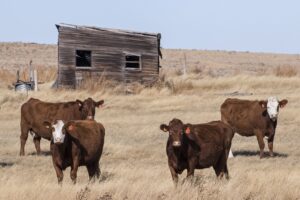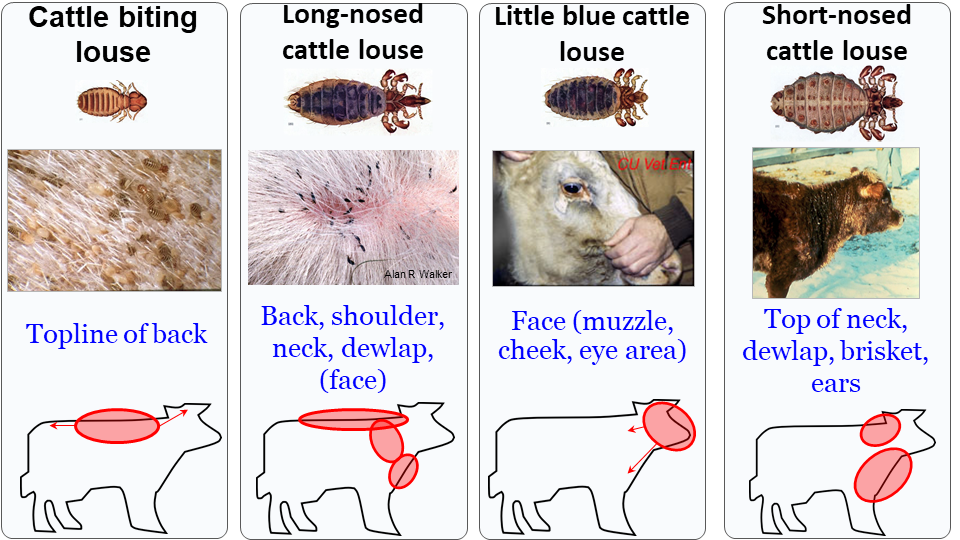Prevent External Parasites from Sucking the Life Out of Your Herd
Remarque : cette page web n’est actuellement disponible qu’en anglais.

External parasites, such as lice, ticks and flies, live on and feed off their host animal. Parasites can cause stress and irritation, reduced weight gain, and production losses in beef cattle, and can also be a vector for diseases. They can pose a problem any time of year for beef producers, however, as winter approaches and cattle start to spend more time in close quarters, parasites such as lice can be a challenge.
Why does it seem like parasites persist in beef herds even after a control product has been applied? What is integrated pest management? What are practices that farmers can do to optimize control? Shaun Dergousoff, PhD, with Agriculture and Agri-Food Canada, and Kateryn Rochon, PhD, from the University of Manitoba gave an overview of Canadian parasites, and addressed common concerns during a recent BCRC webinar.
Managing external parasites is about control, not necessarily elimination. “When it comes to considerations for control, the goal is to reduce harm to livestock and reduce production losses,” says entomologist Shaun Dergousoff. Integrated pest management (IPM) is a key consideration (skip to 9:46). “It’s about using multiple different control methods together to really reduce the number of pests below a threshold, below the point where you lose money,” suggests Dergousoff. There are four main steps of effective IPM.
- The first step is to identify and assess the pest (go to 11:10). What are you dealing with? How abundant are the pests? Is it appropriate to treat?
- Determine prevention and treatment options is step two (skip to 12:48). “There are three different types of control options; you got biological, cultural and chemical,” says Dergousoff. Biological control uses living organisms like predators or parasites to control the pests. Cultural control is focused on preventative measures and practices that reduce pest populations and frequency of outbreaks. For example, sanitation and manure removal can reduce sites favourable to the development of pests. Chemical control is a common method however producers must consider timing, mode, and class of insecticide used (skip to 14:34).
- Implement prevention and control measures is the third step (go to 15:21).
- The final step is to monitor effectiveness (skip to 16:06). Did pest populations go down? Did they rebound? Is retreatment necessary? Has animal behaviour changed?
Lice are common in beef herds, particularly during winter confinement (go ahead to 41.39). Lice can cause extreme stress to animals and cattle can expend a lot of energy dealing with rubbing, licking, and scratching, explained Kateryn Rochon, associate professor with the University of Manitoba. In severe cases, lice can even cause anemia.

There are two different types of lice that affect beef cattle, chewing lice and sucking lice. There is only one species of chewing lice in Canada (cattle biting louse) and they are often found on the topline and flank of affected animals. Sucking lice, such as the long-nosed cattle louse, the little blue cattle louse, and the short-nosed cattle louse, are often found along the head and shoulders of affected animals.
Image courtesy of Kateryn Rochon. Lice illustrations: Ellen Edmonson. Biting louse infestation credit unknown; long-nosed louse infestation photo by Alan R. Waler (CC BY-SA); little blue cattle louse infestation photo by Philip Kaufman; short-nosed infestation photo by John E. Lloyd.
“There are things you can do to prevent getting lice,” explains Rochon (skip to 44:16). She recommends inspecting replacement animals, isolating any infested animals, monitoring your herd regularly, and culling chronic carriers as useful preventative measures.
Chemical control can be a valuable pest management strategy; however, it must be used carefully or it can lead to ineffective control or parasite resistance (go to 46:57). Responsible chemical control practices include:
- Always follow label directions;
- Apply the correct product for the target species at the appropriate time of year and at the proper dosage;
- Alternate using products with different modes of action and active ingredients;
- Avoid applying spray- or pour-on products when it is colder than -10°C to prevent freezing and ineffective coverage;
- Adjust dosage according to animal weight;
- Avoid applying product to wet animals;
- Keep good production records so you can quickly review products used in the past;
- When controlling lice, avoid treating animals too early in the fall when temperatures are still warm;
- Discuss pesticide selection and use with your veterinarian.
A continued responsibility to understand external parasites, monitor their activity, and implement careful management and control strategies will help producers mitigate the impact of external pests on production, health and welfare.
Learn More
- External Parasites (BCRC web page)
- Prevent External Parasites from Bugging Your Cattle (BCRC webinar)
Click here to subscribe to the BCRC Blog and receive email notifications when new content is posted.
The sharing or reprinting of BCRC Blog articles is welcome and encouraged. Please provide acknowledgement to the Beef Cattle Research Council, list the website address, www.BeefResearch.ca, and let us know you chose to share the article by emailing us at info@beefresearch.ca.
We welcome your questions, comments and suggestions. Contact us directly or generate public discussion by posting your thoughts below.